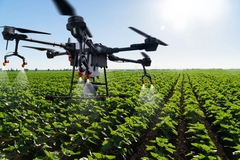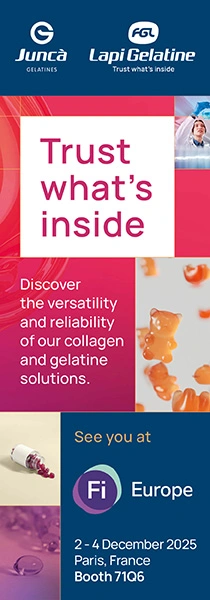Rebuilding trust: BlueTree CEO highlights how to restore consumer confidence in the US food supply
Amid rising consumer concerns about additives, food safety, and increasing US FDA attention on food dyes, F&B innovators are closely monitoring shifting government policies while overcoming technical and commercial challenges to keep pace with consumer demand.
This year, the food industry has witnessed a slew of regulatory changes in the US, led by Robert F. Kennedy Jr.’s Make America Healthy Again initiative, with more seemingly on the horizon.
Some believe that a raft of new policies will do something to boost America’s confidence in the US food supply chain, which has dropped to an all-time low, according to recent data from the 2025 IFIC Food & Health Survey. Just over half of Americans say they are “very” or “somewhat confident” in the safety of the US food supply (55%) — a sharp drop from 62% in 2024 and 70% in 2023.

Michael Gordon, CEO of BlueTree Technologies, talks to Food Ingredients First about the influence of global health and regulatory policies on beverage formulation, along with the technical and commercial challenges manufacturers face in meeting expectations without sacrificing product quality. He also examines how food-tech innovation can restore consumer trust by eliminating additives without compromising taste or nutrition.
The food tech firm is a global player in clean label sugar reduction for natural beverages. The company recently received regulatory clearance to market its sugar-reduction system for fruit juices across the EU without prior approval.
The company’s patented technology safeguards essential nutrients and maintains aroma, texture, and other molecule-derived sweetness levels. The technology combines different separation techniques to selectively eliminate sugar molecules from juices and milk products.
Consumer trust in food safety is at a decade low. What are the key drivers behind rising consumer concerns about food additives and ingredients?
Gordon: Consumers today are more informed than ever. They read labels, research ingredients, and share experiences instantly. That’s a double-edged sword for the industry. While consumer knowledge is informative, it also exposes gaps in transparency and consistency. Additives, especially when poorly communicated, raise concerns. People want products that are natural, recognizable, and predictable in quality. Trust is lost when there’s any perception of compromise, whether it’s in flavor, nutrition, or authenticity.
How does your approach differ from traditional sugar substitutes, and how can it help rebuild trust?
Gordon: We don’t replace sugar, we remove it. Our approach is to selectively remove specific sugar molecules that don’t alter taste or nutrient value, preserving the original integrity of the product. This means consumers get the same taste experience they expect, with reduced sugar and no additives or artificial ingredients. It’s transparent, predictable, and aligns with the growing demand for clean labels. When consumers know exactly what they get from a product and the ingredients are simple, F&B brands can begin to regain their trust.
What strategies have proven most effective in meeting the need to balance taste, nutrition, and clean labels?
Gordon: Many F&B companies are juggling product development, process improvements, and daily operations, so delivering great-tasting, nutritious, clean label products can’t be their only focus. The most effective strategies are science-led, consumer-driven, and start with the taste. By focusing on taste first, and then identifying opportunities to reduce ingredients that don’t add nutritional or sensory value, you respect the original product. At BlueTree, we focus on technology that enhances natural qualities, not hides them.
While internal innovation matters, limited time and budgets can hold companies back. Food-tech start-ups fill this gap by perfecting one small but critical part of the process, offering ready-made expertise. True progress comes from collaboration across R&D, production, and quality teams. By combining internal efforts with specialized partners, manufacturers can accelerate development while protecting taste, nutrition, and clean label standards.
With your background at Coca-Cola, you’ve seen the pressures on large-scale F&B companies. What lessons from your corporate experience guide how you now approach innovation and transparency at BlueTree?
Gordon: Coca-Cola taught me the importance of consistency and brand trust, which can make or break a product at scale. At BlueTree, I carry that with me, but pair it with agility. We work quickly with partners to scale healthier, reduced-sugar products while helping them build the kind of consistent brand their consumers expect. Just as important as transparency, being open about how we innovate and why, because without it, trust can’t be sustained. Open communication is key, both with partners and end consumers, and it’s what keeps innovation credible.
Regulators and consumers are calling for stricter oversight. How do you see regulation evolving in the next five years?
Gordon: Regulation will increasingly favor natural, minimally processed ingredients and demand full transparency. Companies should anticipate that by embedding clean label thinking from day one, through formulation, sourcing, and labeling, they can achieve a more sustainable and transparent approach. Those who embed clean label thinking now will be ahead of both regulation and consumer demand. The ones who prepare proactively won’t just comply; they’ll build long-term credibility and a real competitive edge.
How is BlueTree helping manufacturers prepare for this accelerated phase-out of synthetic dyes?
Gordon: Color, like sugar, is part of the sensory story. Our experience with clean label sugar reduction has taught us that technology can preserve the qualities consumers expect while eliminating artificial inputs. For example, in collaboration with beverage partners, we’ve shown how our selective separation technology can remove excess sugars while maintaining the natural color and sensory profile of fruit juices, eliminating the need for artificial dyes.
The same principle applies to reformulation strategies, where natural concentrates or fermentation-derived pigments can replace synthetic colors without compromising taste or appeal. We’re working closely with manufacturers to bring these solutions to market, ensuring products meet both regulatory requirements and consumer expectations.
Beyond sugar reduction, what broader clean label or ingredient-transparency innovations do you see gaining momentum across the industry?
Gordon: Functional ingredients, fermentation-derived flavors, and enzymatic processes are gaining traction. Consumers want products that are not only safe and natural but also meaningful, providing nutritional or sensory value. Ingredient transparency paired with functional benefits is where the next wave of innovation is going, and it’s already partially here, but there is still a journey ahead of us.
I believe in this work, not for my generation, but so that future generations won’t know a world without ingredient transparency or even any additives. Consumers are going to push the industry in that direction.
What can the industry do to restore long-term confidence in the US food supply?
Gordon: Pioneers can lead by example, showing that high-quality, clean label products are scalable and economically viable. We can demonstrate that reducing sugar or removing additives doesn’t mean sacrificing taste or consumer appeal. Industry-wide trust requires unified standards and transparency, not just isolated innovation, but a solid commitment to clean solutions. Long-term confidence comes when consumers see consistent, honest, and safe products across the board, not just from a few innovators.











